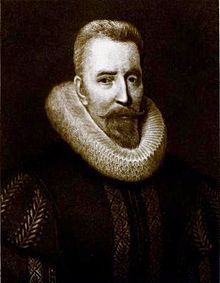Jean Ker, Countess of Roxburghe
Jean Ker, Countess of Roxburghe, née Drummond (c.1585–1643) was a Scottish courtier, a member of the household of Anne of Denmark in Scotland and England.
Drummond was a gentlewoman in the household of Anne of Denmark, described as her "familiar servitrix", and had care over the infant Prince Charles at Dunfermline Palace in 1602.
[2] The Prince, known as "Duke Charles", was slow to learn to walk and an oak stool with wheels to help train him was delivered to Jean Drummond, described in the Scots language as a "tymber stule with rynand quheillis to gang in".
These included "my Cousin Drummond" and Anna Hay with Elizabeth Carey, and they were given presents of gold chains and Spanish leather gloves.
[8] Jean Drummond and Anna Hay, later Countess of Winton, as important members of the queen's household were allocated two footmen to attend them, Andrew Robinson and George Baron.
[10] The Privy Council suggested economies in the royal households by reducing the amount of food allowed in October 1605.
Jean Drummond's allowance was a "diet of 7 dishes" and this might be reduced to a "chamber mess of two" which the other ladies at court received.
An Italian poet in London, Antimo Galli wrote verses about the event, mentioning her, and also published a sonnet in her praise, in the style of Torquato Tasso.
[15][16][17] The imagery celebrates Drummond's friendship with the queen and may reflect a motto used by Anne of Denmark, La Mia Grandezza Dal Eccelso, my greatness comes from on high.
[18] Translated by Jamie Reid-Baxter, the sonnet reads:The prudence and the courage which reignIn you, Jean, are such, that observers are leftBoth astonished, reverent and enamoured:Since you are a woman whose soul is worthyOnly of heaven, and such that it does not disdain,O great Lady, to open up the great secrets of the heart:And hence, now that its splendour has madeClear your lovely thoughts, you teach us to rely on God.Neither Artemisia, nor Zenobia, or any otherMore celebrated Lady, present or past,Has ever possessed so many graces.O Friend of heroic virtue and of glory,Having set all worldly pleasures at naught,You make heaven enamoured of your lovely soul.
[19]In June 1609 Drummond and Lady Fleetwood stayed at the bedside of her kinsman and servant of the queen, David Abercromby, who was dying and he declared his will to them.
[22] At the end of November 1610 one of Drummond's maids died from the plague in her lodgings at Greenwich Palace and the queen returned to Whitehall for fear of infection.
[28] Drummond wrote;"I acquentit hir Maiesti with your gud luk; for the king no shuner gaive you mony for your mynd, bot God send you a chyld to bestow it on.
[35][36] Tassis and the Constable of Castile gave her an aigrette studded with 75 diamonds in 1604, made in Brussels by Jean Guiset.
[37] In 1611 the Spanish ambassador Alonso de Velasco wrote that a Catholic priest was concealed at the court of Anne of Denmark, posing as Drummond's servant.
[38] On 29 July 1612, a Spanish diplomat, the Marquis de Flores spoke with her at Somerset House after his audience with the queen.
[41] In 1615, the English ambassador in Madrid, John Digby, made inquiries about the rewards she received, and reported to King James, "in the list for a distribution of the Spanish ambassador in England, his ordinary allowance a thousand five hundred crowns, ordained to be bestowed upon occasions in presents and New Year's gift upon Lady Jane Drummond.
But I am bound withal in conscience to let your Majesty understand that in all the advertisements that have come to my hands, I cannot perceive that she ever received any thing, but only a slight jewel or two, and a basin and ewer of some rich stone given by the Spanish ambassador in England, as I conceive at her marriage.
[42] In November 1611 Drummond compared the queen's reputation to be content among "hermites pictures in a paltry gallery" with the Earl of Salisbury's "great employments in fair rooms".
[43] Her remark draws attention to Anne of Denmark's collection,[44][45] and contrasts the smaller and more private spaces housing the queen's pictures with the halls and presence chambers where public statecraft was enacted.
[47] In 1612 and 1613 Drummond was involved in the affairs of her friend Anne Livingstone, who was trying to have her husband Alexander Seton of Foulstruther recognised as Earl of Eglinton.
[48] Drummond wrote to Anne Livingstone of developments during the queen's progress to Bath following the wedding of Princess Elizabeth and Frederick V of the Palatinate.
The wedding feast and Daniel's masque was said to have cost the queen £3000, and it was an opportunity for her to show off the recent refurbishment of Somerset House.
[61] Alexander Seton, 1st Earl of Dunfermline, wrote to her to 1614, asking John Murray to deliver the letter to "my Lady Roxbrough, my sister".
[67] On 10 May 1617 Drummond signed a receipt as "Jane Roxbrough", for a £500 installment of the king's gift of £3,000 to her "in consideration of long and faithful service done to the Queen, as one of the ladies of the bedchamber to her Majesty.
[74] An account of her and her husband's expenses from 1619 to 1630 runs to 550 pages, and mentions her residence at East Roxburgh, a townhouse in Edinburgh's Canongate, and Broxmouth near Dunbar.
[76] The household book records spices and food seasonings such as cinnamon, mace, ginger, and sugar almonds bought in Edinburgh and sent to East Roxburgh, as were materials and ribbons for clothing.
On 20 May 1639, Jean Roxburghe wrote from Whitehall to Walter Balcanquhall, Dean of Durham, expressing her disappointment over this defection.

